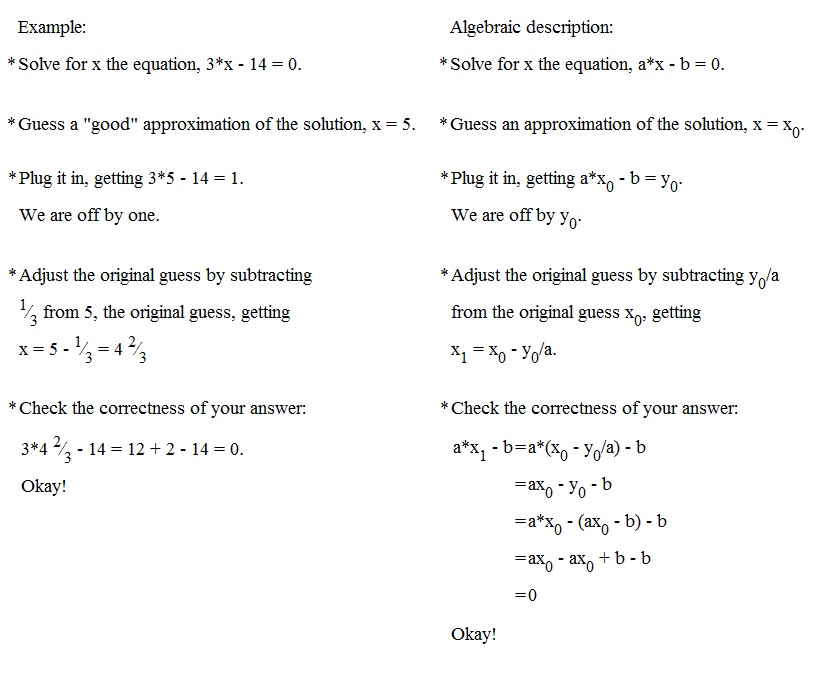Understanding Newton's Method: False Position
A
linear equation, a*x - b = 0, can be solved for x by division, x = b/a. But in
ancient times division was considered difficult, and such equations were often
solved by the Method of False Position. We will show this method using modern
notation.
Example
Solve for x the equation, 3*x - 14 = 0.
* Guess a "good" approximation of the solution, x = 5.
* Plug it in, 3*5 - 14 = 1.
* Adjust the original guess, x = 5 - 1⁄3 = 4 2⁄3
* Check the correctness of your answer: 3*4 2⁄3 -
14 = 12 + 2 - 14 = 0.
Remark.
In ancient times, subtracting a unit fraction (a fraction with one in the
numerator) was simpler than dividing.
An algebraic description of this method with parallels to the example above:
Now comes calculus.
Let f(x) = a*x - b.
The derivative of f(x) relative to variable x is f'(x) = a. (Can you derive
this?)
(Notice that the derivative of this particular function is constant, but this
is a "rare event".)
Solve for x the equation f(x) = 0, by Newton's method.
- Guess an approximation of the solution, x = x0.
- Plug it in, getting y0 = f(x0).
- Adjust the original guess, x1 = x0 - y0/f'(x0).
- Check the correctness of your answer, f(x1) = y1 .
- If y1 ≠ 0, choose x = x1 as your
"improved" guess and repeat the whole process again and again, until
you get a satisfactory approximate solution of the equation f(x) = 0.
Newton's algorithm formulated in modern terms:
In order to solve the equation f(x) = 0 for x, choose an initial value x0,
and then,
|
x0 → x; |
|
repeat, x - f(x)/f'(x) → x; |
|
until f(x) is "close enough" to 0, and/or the
new value of x "is close enough" to the previous one. |
Remark.
The meaning of "close enough" depends on the problem at hand.
Working with SOLVER on the TI-83/84.
You enter into SOLVER an equation F = 0, where F is a function that can depend
on many variables. You specify the variable V for which you want the
equation to be solved. (It doesn't have to be X.) The
values of the other variables will remain unchanged. The current
value of V becomes the initial guess. SOLVER repeats the operation V
- F/nDeriv(F,V,V) → V.
If the process is successful, you get a value of V which is an approximate
solution of F = 0, with information regarding how close F is to 0. Remember
that "exactly" means only "within the accuracy that can be
achieved by this calculator".
If you do not get a solution, it could mean one of two things. Either
there is no solution, or the calculator failed to find one.
For example, enter into SOLVER (under MATH)
eqn:0=X2.
Try to solve it (ALPHA SOLVE) for the initial guess X = 1.
X2=0
X=1
bound={-1E99,1...
You will get the message,
ERR:NO SIGN CHNG
In this case, the calculator failed to find the (obvious) solution X=0!
(dummy!)
Here is an example of using Newton's method to solve an equation, emulating
what SOLVER does, on the homescreen of the TI-83/84.
Solve x2 = 5. (No square root button!)
This is the same as x2 - 5 = 0.
In the calculator, enter Y1=
X2 - 5
Now from the home screen enter a guess for X, say 2:
2→X
X-Y1/nDeriv(Y1,X,X)→X
|
ENTER |
|
|
|
2.25 |
|
ENTER |
|
|
|
2.236111111 |
|
ENTER |
|
|
|
2.236067978 |
|
ENTER |
|
|
|
2.236067977 |
|
ENTER |
|
|
|
2.236067977 |
Now enter
|
√5 |
|
|
|
ENTER |
|
|
|
2.236067977 |
Webpage Maintained by Owen Ramsey
Calculus Index
Calculus Index
